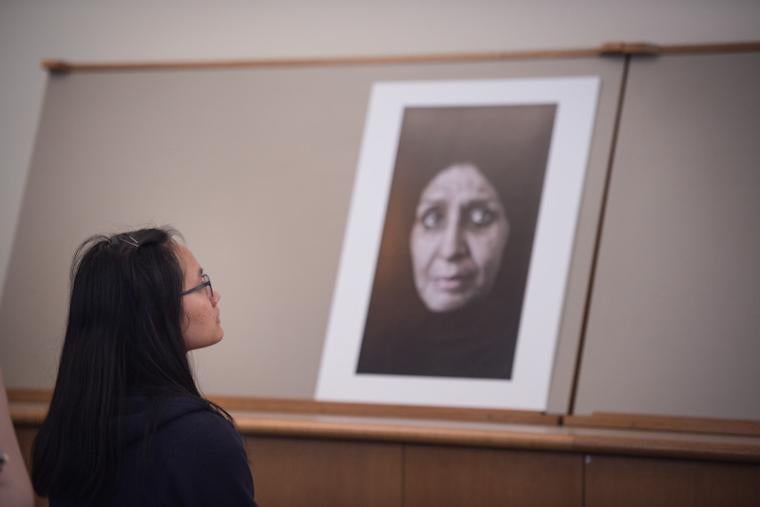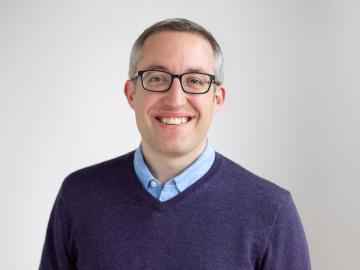The Art of Observing
April 12, 2016
Amanda Nagy

Over the past three years, students in Catherine Oertel’s general chemistry and inorganic chemistry courses have been studying visual art through coordinated visits to the Allen Memorial Art Museum (AMAM).
The obvious question is, what can observing and interacting with art teach students about chemistry?
“There’s a lot of value in being placed in front of something unfamiliar to you and being asked to make some observations to defend what you’re saying is present,” says Oertel, associate professor of chemistry and biochemistry. An example she’s used is a series of photographs by Harold Edgerton (1903-1990), a professor at MIT who invented the electronic flash, a device that could capture images the human eye cannot see. His pioneering technology photographed events such as a bullet slicing through an apple and the first fractions of a second of a nuclear explosion.
“In some of the photographs you can recognize right away what’s being depicted. In others, it’s kind of disorienting at first because it’s hard to tell what’s going on. In looking at these objects, we are able to make careful visual observations, talk about what we think is being represented, and speculate about how this photograph may have been taken. Sometimes, the order of events being depicted is ambiguous, so we come up with proposals for what we think the order might have been, talk about different options, and defend what we think is the best conclusion. We can draw parallels between this and the scientific process.”
In working closely with Liliana Milkova, AMAM curator of academic programs, and other faculty who teach at the museum, Oertel says she’s come to appreciate the idea that there are broader skills to be gained by interacting with objects of visual art—skills that go beyond a specific course and chemical topic.
Although the museum is well integrated in Oberlin’s curricular experiences, the concept of art engagement as a teaching tool is starting to take hold in medical schools across the country. Oberlin’s premed program held a workshop at the museum on March 16 called “Training the Eye: Art Engagement in the Medical Profession,” which was geared toward premed students.
Professor of Neuroscience Lynne Bianchi, Oberlin’s premed faculty advisor, said the AMAM workshop is the first of its kind at Oberlin; it’s also an uncommon offering for an undergraduate institution.
Oertel was part of a panel discussion that included Dr. Lisa Arfons, assistant professor of medicine in hematology and oncology and associate residency program director at Case Western Reserve University; Laura Martin, professor emerita in anthropology, modern languages, and health sciences at Cleveland State University; and Christina Neilson, associate professor of Renaissance and baroque art at Oberlin.
Developing the Whole Person
At Case, Arfons has been leading the charge for helping residents develop their clinical skills. She talked about how she came to realize when, as she was beginning her practice as an attending physician at the Louis Stokes Veterans Hospital in Cleveland, she had been trained to treat the so-called “i-Patient”.
“Rather than the real patient, you have this electronic version of a patient. “Case is a very progressive medical school. They’re interested in developing the whole human and what we do outside of class. However, it’s only as good as our experiences will allow.
“I felt like my medical training, from the time I was in organic chemistry all the way to when I finished my fellowship training, had culminated in teaching me how to take care of the i-Patient—looking at the computer, looking at a CAT scan, looking at a patient’s blood work—instead of standing at the bedside and talking to that patient. I desperately wanted to get back to that. I think it’s important in all practices of medicine, but as an oncologist who deals with terminal conditions, it’s important to shift my focus,” she says. “As I was teaching residents, I wanted to see if there was something we could do collectively to get our focus back to the real patient.”
Around the same time she was finishing her fellowship, Arfons began working with Martin in developing ways to bring art to residents’ training. She devised a two-week block that takes them out of the hospital. With no on-call schedule and no patient care, it provides a much-needed respite from the 80-hour, six-day rotation.
“This year, we focused on the core tenets of medical education that residents really wanted to learn about, things like procedures and bedside skills—true clinical skills. We also did quality improvement and high-value care. That’s a huge practice now with making sure that we are practicing economically to sustain medical care for everybody.”
During this two-week block, Martin led a session at the Cleveland Museum of Art. Although she never trained as an artist, she came to the program with expertise in ethnography and teaching observation skills.
“Observation is core to all the sciences, social sciences and humanities included. We have to practice really seeing because our brains habituate ways of seeing that speed up and solve the problem of too much stimulus to get to the answer,” Martin says. “Science and medicine teach us to speed up the process. For example, ‘Here are the recorded test results, here is a complaint, so here is the most likely reason.’”
In her gallery exercises, Martin tells residents to put their own bodies in the position of the person in a painting or sculpture, and asks them how they feel. “How can you appreciate the body mechanics, the way gravity pulls on you, the psychological sense you get from being in this position? The experience of hearing how multiple people have totally different understandings of the things they’re looking at enhances our ability to empathize. It enhances our ability to communicate across disciplinary boundaries, across cultural boundaries, across experiential boundaries.”
Martin believes learning about one’s own perceptual habits, assumptions, and biases is one of the most important things to gain by consistent interaction with art objects.
“Slowing down, taking your time, reflecting together, being surprised by other people’s interpretations—all that is a reminder that, in health care professions, you’re dealing with a whole person who comes with an entire history.”
These ideas were demonstrated in two different breakout sessions. In the Print Study Room, Milkova led participants in an observation exercise using a piece of bronze sculpture and an accompanying photograph of the sculpture, an etching and engraving, and a photograph. Breaking into three groups, participants were instructed to discuss their first impressions and answer guiding questions about each art work, then present their findings with the larger group.
In the Ripin Gallery, Neilson led a focused viewing of the exhibition A Picture of Health: Art and the Mechanisms of Healing. The exhibition, co-curated by Neilson, explores how art is perceived to bring about the health and well-being of its makers and beholders. The collection of paintings and objects—including amulets worn for healing and protection—examines diverse modes of healing through art from the United States, Asia, Africa, Europe and the Middle East. The exhibition is on display through July 3.
For fourth-year biochemistry major Kendra Lian, Oertel’s inorganic chemistry course “has been a gateway to appreciating the beauty and the art that lies behind chemistry.”
“Art is intrinsically tied to the scientific process because it teaches us to use ‘the familiar’ to seek a whole new perspective, and I find that really inspiring,” she says.
During the panel discussion, Martin discussed the importance of tolerating ambiguity in the medical field, and that idea resonated with her. “I was struck by how simple but true that statement is. I think I've always appreciated art for its ability to capture order and beauty despite all the ambiguity that surrounds us,” says Lian, who is from Ann Arbor, Michigan. “In science and research especially, we don't always know what we're going to find, but it's amazing that despite the unknowns, we still manage to find certain patterns and structures to give us answers. I consider those experimental results to be an art form as well.”
Second-year Katherine Christel also compares science and medicine to a form of art—"from the more literal sense of surgeons physically changing something to the drawings of Leonardo de Vinci."
A pre-med biology major from Wooster, Christel says she will apply what she learned from the workshop to her lab experiences. "I will take more time looking at an individual piece and try to speculate what might be happening or what could be an underlying message. I will try to push myself to participate in more things that are slightly outside of my comfort zone, because I believe that is how I can continue to grow as a person and develop new ways of thought."
Tags:
You may also like…
Longtime Allen Memorial Art Museum Director Andria Derstine Announces Departure
October 14, 2024
Omar Tells His Story
October 11, 2024
3 Things with Matthew Rarey
January 31, 2024


